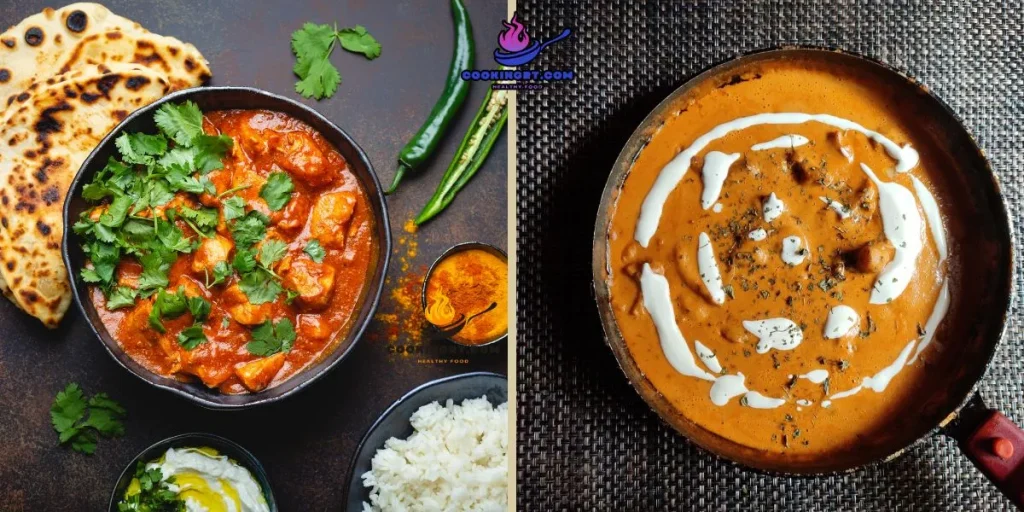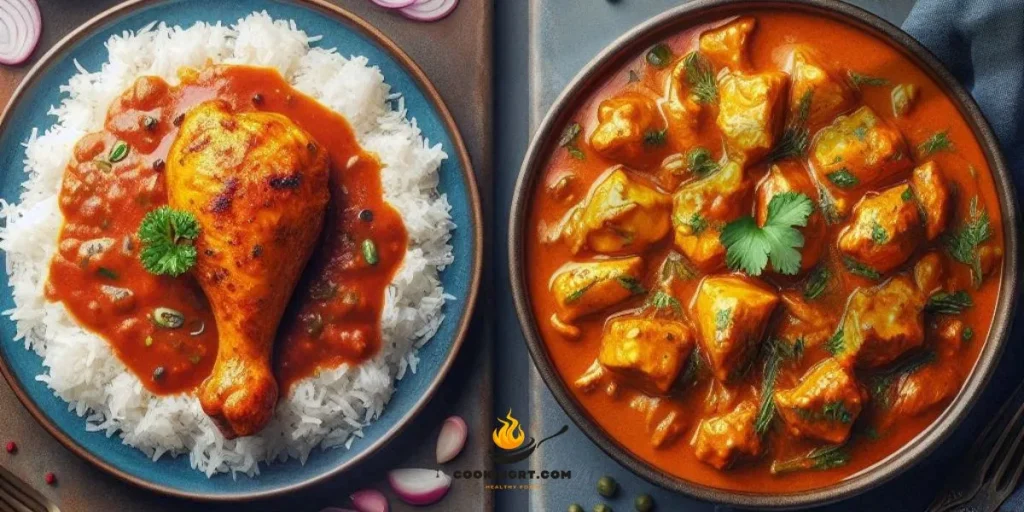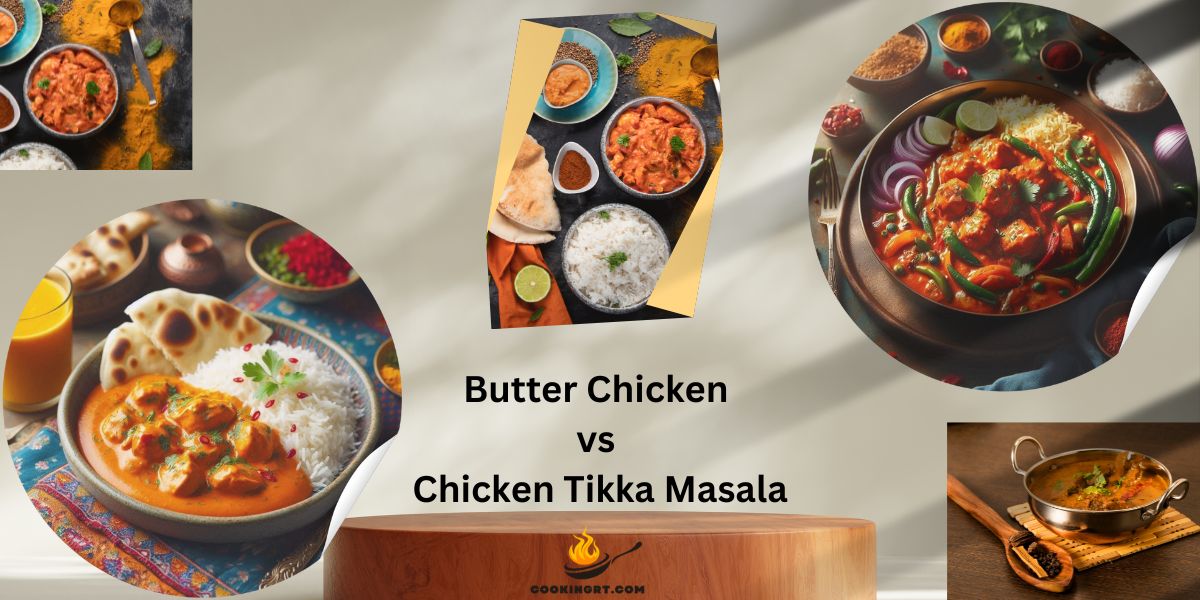When it comes to Indian cuisine, few dishes evoke as much debate and passion as Butter Chicken and Chicken Tikka Masala. Both are beloved by masala indian food enthusiasts around the globe, yet each offers a distinct culinary experience that reflects the rich tapestry of flavors found in Indian cooking.
In this article, we’ll dive deep into the world of these two iconic dishes, exploring their unique ingredients, preparation methods, and flavor profiles. Join us for a Butter Chicken vs Chicken Tikka Masala as we uncover which dish reigns supreme on your plate. Whether you prefer the creamy, buttery goodness of Butter Chicken or the tangy, spiced allure of Chicken Tikka Masala, one thing is certain: your taste buds are in for a delightful journey!
Origins of the Dishes
Here’s a detailed overview of the origins and historical backgrounds of Butter Chicken and Chicken Tikka Masala:
Historical Background of Butter Chicken
Butter Chicken, or Murgh Makhani, has its roots in North India, specifically in the bustling city of Delhi. It was created in the 1950s by the chefs at the Moti Mahal restaurant, a renowned establishment that sought to utilize leftover chicken from the tandoor (clay oven) in a new and exciting way.
Creation: The dish was invented by the founders of Moti Mahal, who combined leftover chicken with a rich tomato gravy made with butter and cream, along with a blend of spices. This innovation not only rescued leftover food but also created a deliciously creamy dish that quickly gained popularity.
Culinary Influence: Butter Chicken is influenced by traditional Mughlai cuisine, which is known for its use of rich and creamy gravies. The dish reflects the Mughal emphasis on opulence and flavors, melding aromatic spices with a buttery sauce.
Global Popularity: Over the decades, Butter Chicken transcended its local origins and became a staple in indian butter chicken recipe restaurants worldwide, celebrated for its creamy texture and rich flavor profile.
Historical Background of Chicken Tikka Masala
Chicken Tikka Masala is another beloved Indian dish, but its origins are more contested. It is widely believed to have been developed in the UK, reflecting the fusion of Indian cooking with British tastes.
Creation: The dish is thought to have originated in the 1960s or 1970s. One popular account credits it to a chef at the Taj Hotel in London, who adapted Chicken Tikka (marinated grilled chicken pieces) by adding a spiced tomato cream sauce to satisfy a customer who wanted something more saucy.
Culinary Influence: While Chicken Tikka has its roots in Indian cuisine—marinated in yogurt and spices and then cooked in a tandoor—Chicken Tikka Masala incorporates the British penchant for rich, creamy tikka sauce, blending the two culinary traditions.
Cultural Significance: Over time, Chicken Tikka Masala has become emblematic of Indian cuisine in the UK and is often cited as a symbol of multiculturalism. It was even referred to as “Britain’s national dish” due to its immense popularity among the British population.
Global Reach: Like Butter Chicken, Chicken Tikka Masala has found a place on menus around the world, showcasing the versatility of Indian flavors and the adaptability of its dishes to different palates.
Also, Read More: How To Cook Beef Ribs?
Ingredients Breakdown

Here’s an ingredients breakdown comparing butter chicken and chicken tikka masala spices:
Key Ingredients in Butter Chicken
- Chicken: Typically boneless chicken thighs or breasts, marinated for tenderness.
- Butter: A generous amount of butter creates a rich, creamy sauce.
- Cream: Heavy cream adds to the dish’s richness and smooth texture.
- Tomatoes: Fresh tomatoes or tomato purée provide a base for the sauce.
Spices:
- Garam Masala: A blend of warming spices like cardamom, cinnamon, and cloves.
- Turmeric: Adds color and an earthy flavor.
- Cumin: Provides warmth and depth.
- Coriander: Contributes a citrusy note.
- Kasuri Methi (dried fenugreek leaves): Adds a unique, slightly bitter flavor.
Key Ingredients in Chicken Tikka Masala
- Chicken: Marinated chunks of chicken, often grilled or roasted for a smoky flavor.
- Yogurt: Used in the marinade to tenderize the chicken and add tanginess.
- Tomatoes: Fresh tomatoes or canned tomatoes are blended into the sauce.
- Cream: Adds richness, similar to Butter Chicken.
Spices:
- Garam Masala: Also used, but often with a more pronounced flavor.
- Paprika: Adds color and a subtle sweetness.
- Cumin: Provides warmth and earthiness.
- Turmeric: For color and flavor.
- Chili Powder: Adds heat and depth to the dish.
Differences in Spices and Flavor Profiles
Spices and flavor profiles are key elements in cooking, influencing the taste, aroma, and overall experience of a dish. Here’s a breakdown of the differences:
Butter Chicken
Flavor Profile: Rich, creamy, and slightly sweet, with a buttery finish.
Spices: Emphasizes a smoother blend of spices, including the distinctive taste of kasuri methi.
Chicken Tikka Masala
Flavor Profile: Spicy, tangy, and aromatic, with a smoky undertone from the grilled chicken.
Spices: More robust use of spices like paprika and chili powder, which adds a spicier and more complex flavor.
Preparation Methods
Traditional Cooking Method for Butter Chicken
Marination: Chicken pieces (usually boneless) are marinated in a mixture of yogurt, lemon juice, and a blend of spices such as cumin, coriander, turmeric, garam masala, and chili powder. This process typically lasts several hours or overnight to enhance the flavors and tenderness of the chicken.
Cooking the Chicken: Traditionally, the marinated chicken is grilled in a tandoor (a clay oven) or cooked on a skillet until it’s partially cooked. This imparts a smoky flavor to the chicken.
Making the Sauce: In a separate pot, a rich and creamy tomato-based sauce is prepared. The sauce usually includes butter chicken ingredients like tomatoes, butter, cream, ginger, garlic, and spices. The tomatoes are often pureed to achieve a smooth texture.
Combining: The grilled chicken is then added to the sauce and simmered until fully cooked. Additional cream and butter are often stirred in just before serving for extra richness.
Garnishing: The dish is garnished with fresh cilantro and sometimes a drizzle of cream before serving.
Traditional Cooking Method for Chicken Tikka Masala h3
Marination: Similar to butter chicken paste, chicken is marinated in yogurt and spices like garam masala, cumin, and coriander. The marination process enhances flavor and tenderness.
Cooking the Chicken: The marinated chicken is typically grilled in a tandoor, giving it a charred flavor. It can also be cooked on a barbecue or stovetop.
Making the Sauce: The sauce for Chicken Tikka Masala is tomato-based but often includes additional spices like turmeric, paprika, and chili powder, chicken masala powder, and sometimes coconut milk or yogurt for creaminess. Onions are often sautéed and blended into the sauce for added depth.
Combining: The grilled chicken is added to the sauce and simmered until heated through. The dish is often richer than Butter Chicken due to the inclusion of more spices and flavorings.
Garnishing: Fresh cilantro and sometimes a squeeze of lime are added as garnishes before serving.
Also, Read More: Creative Tea Party Ideas for a Charming Afternoon
Variations in Preparation Across Regions

“Variations in preparation across regions” refers to the differences in how certain activities, tasks, or products are prepared or approached in different geographic areas or cultural contexts. These variations arise due to diverse factors such as climate, local resources, traditions, cultural preferences, and technological advancements. Here’s a breakdown of the concept:
Butter Chicken
North India: The classic version is most popular here, with a rich and creamy texture.
West India: Some variations include the addition of nuts or dried fruits for extra richness.
International: In places like the UK, Butter Chicken may be adjusted to include less spice and more cream to cater to local tastes.
Chicken Tikka Masala
UK Variation: Often considered a British national dish, this version may feature a less spicy sauce and can include additional ingredients like bell peppers or green peas.
Regional Variations: In the Indian subcontinent, the spice levels and types of masalas used can vary widely, with some regions opting for more heat and others preferring a milder flavor.
Fusion Versions: In many Western countries, you may find variations that include unique twists, such as different types of proteins or sauces.
Flavor Profiles
Here’s a breakdown of the flavor profiles for Butter Chicken and Chicken Tikka Masala, along with insights into how regional variations affect their taste:
Describing the Taste of Butter Chicken
Creamy and Rich: Butter Chicken is characterized by its indulgent creaminess, derived from the generous use of butter and cream in the sauce. This richness creates a comforting mouthfeel that is deeply satisfying.
Mildly Spiced: The spice level in Butter Chicken tends to be on the milder side, allowing the flavors of the spices (such as garam masala, cumin, and coriander) to blend harmoniously without overwhelming the palate.
Sweet and Savory: The addition of tomatoes and a touch of sugar lends a slight sweetness to the dish, balancing the savory notes. This sweetness makes it accessible to a wider audience, including those who may be sensitive to heat.
Herbaceous Undertones: Fresh herbs like cilantro are often used as a garnish, adding a fresh and aromatic layer to the dish that enhances its overall flavor profile.
Describing the Taste of Chicken Tikka Masala
Bold and Spicy: Chicken Tikka Masala is known for its vibrant and robust flavor, typically featuring a more pronounced spice level than Butter Chicken. The use of spices such as turmeric, paprika, and chili powder gives it a distinctive kick.
Smoky and Charred: The chicken is usually marinated in yogurt and spices before being grilled or roasted, imparting a smoky flavor that enhances the dish’s depth. This charred quality adds complexity to the overall taste.
Tangy and Zesty: The addition of yogurt in the marinade and sometimes in the sauce adds a tangy element that contrasts beautifully with the rich tomato base. This acidity brightens the dish and balances the heat from the spices.
Layered Flavors: The combination of various spices creates a multi-dimensional flavor profile, with each spice contributing its unique characteristics to the overall dish. This makes chicken tikka Masala a delightful exploration of taste with every bite.
How Regional Variations Affect Flavor
Regional Ingredients: Different regions in India utilize locally available ingredients, which can lead to variations in the best butter chicken recipe. For example, in the North, easy butter chicken might incorporate more cream, while in the South, you might find coconut milk as a substitute for a lighter taste.
Spice Levels: Regional preferences for spice levels can significantly alter the flavor profiles of both dishes. In regions known for their spicy cuisine, you might encounter versions of Chicken Tikka Masala that are much hotter, whereas Butter Chicken may remain consistently creamy across regions.
Cooking Techniques: The method of preparation also varies by region. For instance, traditional tandoor cooking imparts a unique flavor to Chicken Tikka, while Butter Chicken might be made in a more home-style manner, focusing on a smoother sauce.
Cultural Influences: The influence of different cultures can also lead to variations. In Western adaptations, both dishes might be toned down in spice and made creamier to cater to local palates, altering their authentic flavors.
Nutritional Comparison
When comparing the caloric content and nutritional profiles of Butter Chicken and Chicken Tikka Masala, both popular dishes from Indian cuisine, we must take into account their ingredients and cooking methods. Here’s an informative breakdown to help readers make an informed decision.
| Nutritional Aspect | Butter Chicken | Chicken Tikka Masala |
|---|---|---|
| Calories (per 250g serving) | 490-540 calories | 350-400 calories |
| Protein Content | ~30g of protein | ~25-28g of protein |
| Fat Content | ~30g total fats (15g+ saturated fats) | ~20g total fats (7-10g saturated fats) |
| Carbohydrates | ~10-15g | ~12-15g |
| Saturated Fats | High (due to butter and cream) | Moderate (less butter, but contains cream) |
| Nutritional Benefits | High in protein, vitamins (B6, B12, A, C) | Protein-rich, antioxidant-rich spices (turmeric, cumin) |
| Nutritional Drawbacks | High in calories, saturated fats, and sugar | Moderate saturated fat, high in sodium |
Serving Suggestions

Both Butter Chicken and Chicken Tikka Masala are rich, creamy, and flavorful dishes from Indian cuisine. Pairing them with the right sides and accompaniments enhances the dining experience. Here’s a detailed guide on the ideal pairings for these popular dishes:
Best Accompaniments for Butter Chicken
- Basmati Rice: Basmati rice is the ideal pairing for butter chicken due to its fragrant aroma and fluffy texture. Its neutral flavor absorbs the creamy tomato-based sauce of the dish without overpowering the rich, buttery taste. A lightly spiced basmati rice enhances the overall experience of this beloved dish.
- Naan Bread: Soft and slightly chewy, naan bread is perfect for scooping up the velvety sauce of butter chicken. Its charred, smoky edges complement the richness of the dish, making each bite more satisfying. Whether it’s garlic naan or butter naan, this bread is a must-have side.
- Cucumber Raita: A refreshing cucumber raita adds a cooling balance to butter chicken’s rich and creamy sauce. The yogurt-based side, combined with grated cucumber, provides a soothing contrast to the spice, making it an excellent palate cleanser.
- Pickled Onions and Lemon Wedges: Adding pickled onions and a squeeze of lemon helps cut through the richness of butter chicken. The tangy and zesty flavors brighten up the dish, offering a refreshing bite that complements the creamy texture.
Best Accompaniments for Chicken Tikka Masala
- Jeera (Cumin) Rice: The smoky, bold flavors of chicken tikka masala are best paired with cumin-flavored rice. Jeera rice, with its nutty aroma, balances the spiciness of the masala, enhancing the earthy undertones of the dish without overpowering the vibrant flavors.
- Tandoori Roti: Tandoori roti, a whole-wheat flatbread, is perfect for mopping up the tangy, tomato-rich sauce of chicken tikka masala. Its slightly crisp exterior and soft, chewy interior make it an excellent complement to the dish’s robust flavors.
- Onion and Mint Chutney: Mint chutney, with its fresh, herbaceous flavor, contrasts beautifully with the smoky and spicy chicken tikka masala. The sharpness of onion combined with the coolness of mint adds a refreshing twist, lifting the overall flavors of the dish.
- Pappadums: Thin and crispy, pappadums provide a delightful crunch alongside the creamy texture of chicken tikka masala. Their lightly spiced flavor and crispiness add a perfect textural contrast, making them a versatile side to enjoy with the meal.
Cultural Significance
Here’s an informative exploration of the cultural significance of Butter Chicken and Chicken Tikka Masala, highlighting their roles in Indian culture and beyond:
Role of Butter Chicken in Indian culture
Butter Chicken, or Murgh Makhani, is a beloved dish that has become a staple of Indian cuisine. Originating from Delhi in the 1950s, this dish was created by the chefs at the Moti Mahal restaurant. The story goes that leftover chicken from the tandoor (a traditional clay oven) was cooked in a rich tomato-based gravy, enhanced with butter and cream, resulting in a dish that is both rich and flavorful.
Symbol of Indian Hospitality
In Indian culture, food plays a crucial role in hospitality and social gatherings. Butter Chicken is often served during celebrations, festivals, and family gatherings. It symbolizes warmth and generosity, as its rich flavors and creamy texture appeal to many, making it a crowd-pleaser. The dish is typically accompanied by naan or rice, creating a complete meal that encourages sharing and togetherness.
A Culinary Icon
Butter Chicken has transcended its origins to become an icon of Indian cuisine. It is not only a testament to the innovation of Indian cooks but also reflects the fusion of flavors and techniques from different regions. The dish showcases the use of spices, which are fundamental to Indian cooking, making it an essential introduction for those unfamiliar with Indian food.
Role of Chicken Tikka Masala in Indian culture and abroad
Chicken Tikka Masala is another dish that holds significant cultural importance, both in India and globally. While its exact origins are debated—some claim it was invented in India, while others argue it was developed in the UK—it has become synonymous with Indian cuisine worldwide.
A Global Phenomenon
In the UK, Chicken Tikka Masala has been dubbed a “national dish,” highlighting how it has been embraced and adapted by British culture. This dish illustrates the impact of Indian immigration and the evolution of culinary traditions in multicultural societies. It combines marinated chicken pieces grilled in a tandoor with a spiced tomato sauce, creating a dish that is not only flavorful but also reflective of cross-cultural culinary exchanges.
A Fusion of Cultures
The popularity of Chicken Tikka Masala exemplifies how food can bridge cultural divides. In India, it is enjoyed in homes and restaurants, often paired with naan or rice. Abroad, it has been adapted to cater to local tastes, incorporating different ingredients and preparation methods. This adaptability showcases the flexibility of Indian cuisine, allowing it to resonate with diverse palates.
Culinary Identity
Both Butter Chicken and Chicken Tikka Masala contribute to the global perception of Indian cuisine. They represent the rich culinary heritage of India, showcasing its flavors and cooking techniques. As these dishes gain popularity, they foster a greater appreciation for Indian culture, encouraging people to explore more traditional chicken masala recipe and ingredients.
Popularity and Global Reach
Here’s an informative piece comparing the global popularity and reach of Butter Chicken and Chicken Tikka Masala, including their journeys and regional preferences:
How Butter Chicken Became a Global Favorite
Butter Chicken, known as Murgh Makhani in India, originated in the 1950s in Delhi. It was the brainchild of the chefs at the Moti Mahal restaurant, who crafted this dish to utilize leftover chicken masala and tomato gravy. The chicken tikka recipe features marinated chicken cooked in a rich, buttery tomato sauce, spiced to perfection.
Its rise to global fame can be attributed to the increasing interest in Indian cuisine and the dish’s perfect balance of flavors. With its creamy texture and mild spices, Butter Chicken appeals to diverse palates, making it an ideal introduction to Indian food for many.
As Indian restaurants began to proliferate worldwide, particularly in the UK, the dish found its way onto menus, quickly becoming a staple in Indian dining. Its popularity soared as food enthusiasts embraced the convenience of ready-made butter chicken sauce recipe and frozen meals. Today, butter chicken recipe easy is not only a favorite in Indian restaurants but also a common dish in households around the world, often paired with naan or rice.
Also, Read More: Can You Freeze Key Lime Pie?
The Journey of Chicken Tikka Masala as a Popular Dish Outside India
Chicken Tikka Masala (CTM) boasts a similar trajectory, with its roots traced back to Indian and Pakistani cuisine. However, its global ascent took a unique turn in the UK during the 1960s. It is believed that the dish was created by Bangladeshi chefs in response to British tastes, combining grilled chunks of marinated chicken (tikka) with a spiced tomato-based sauce.
CTM’s rapid popularity in the UK led to its recognition as a quintessential British dish, even prompting former Foreign Secretary Robin Cook to declare it “a true British national dish” in 2001. The dish’s success can be attributed to its adaptability; it can be made with varying levels of spice and richness to suit different preferences.
As the dish made its way across Europe, North America, and beyond, it maintained its core identity while embracing local ingredients and culinary styles. The rise of Indian takeaways and fast-casual dining has further solidified Chicken tikka masala place on the global stage.
Comparison of Their Popularity in Different Regions
When comparing the popularity of Butter Chicken and Chicken Tikka Masala, notable regional differences emerge:
India: While both dishes are enjoyed, they represent different dining experiences. Butter Chicken is often seen as a comfort food, while Chicken Tikka Masala is commonly enjoyed in various forms, from street food to upscale dining.
United Kingdom: Chicken Tikka Masala reigns supreme, often outpacing Butter Chicken in terms of recognition and consumption. It has become a staple in British curry houses and is widely available in supermarkets.
United States: Both dishes are popular, but Butter Chicken tends to have a stronger following among those exploring Indian cuisine for the first time. Many American diners appreciate its creamy texture and rich flavor.
Canada: Chicken Tikka Masala has found a special place in Canadian cuisine, often celebrated for its versatility. However, Butter Chicken is not far behind, frequently appearing on restaurant menus.
Australia: Both dishes enjoy popularity, with Butter Chicken being favored for its comforting nature and rich flavors. Indian restaurants in major cities often feature both as house specialties.
Conclusion
In the battle of Butter Chicken vs Chicken Tikka Masala, both dishes showcase the rich and vibrant flavors of Indian cuisine, yet they each offer a unique dining experience. Butter Chicken, with its creamy, tomato-based sauce and tender chicken, provides a comforting and indulgent taste that’s perfect for those who crave a mild, rich flavor. On the other hand, Chicken Tikka Masala boasts a spicier profile, featuring marinated grilled chicken in a fragrant, spiced sauce, appealing to those who enjoy a more robust and complex flavor.
Ultimately, your choice between these two beloved dishes may come down to personal preference. If you favor a rich, buttery experience, Butter Chicken is your go-to. However, if you’re seeking a vibrant dish with a bit more heat, Chicken Tikka Masala will satisfy your palate. Either way, both dishes are delicious representations of Indian cuisine, making them worthy of a spot on your plate!
Frequently Asked Questions (FAQ’s)
Q: What is the main difference between Butter Chicken and Chicken Tikka Masala?
Ans: The primary difference lies in their preparation and sauce. Butter Chicken features a creamy tomato sauce enriched with butter and cream, while Chicken Tikka Masala has a spicier, more robust sauce made with a blend of spices and tomatoes.
Q: What are the key ingredients in Butter Chicken?
Ans: Key ingredients typically include chicken, butter, cream, tomatoes, garlic, ginger, and a mix of spices like garam masala, cumin, and coriander.
Q: Which dish is more popular globally?
Ans: Chicken Tikka Masala is often considered more popular globally, especially in Western countries, while Butter Chicken is a beloved dish in Indian cuisine.
Q: What are the key ingredients in Butter Chicken?
Ans: Key ingredients typically include chicken, butter, cream, tomatoes, garlic, ginger, and a mix of spices like garam masala, cumin, and coriander.
Q: What are the key ingredients in Chicken Tikka Masala?
Ans: Key ingredients include marinated chicken (usually grilled), tomatoes, onions, garlic, ginger, and a variety of spices such as cumin, coriander, and paprika.
Q: Can I make Butter Chicken or Chicken Tikka Masala in a slow cooker?
Ans: Yes, both dishes can be made in a slow cooker for convenience, allowing the flavors to meld beautifully over a longer cooking time.
Q: Are Butter Chicken and Chicken Tikka Masala healthy options?
Ans: Both dishes can be high in calories and fat due to the cream and butter. However, they can be made healthier by using less cream, opting for lean chicken, or serving with vegetables.
Q: Which dish is spicier: Butter Chicken or Chicken Tikka Masala?
Ans: Chicken Tikka Masala is generally spicier than Butter Chicken, which has a milder and creamier flavor profile.
Q: Can Butter Chicken and Chicken Tikka Masala be made vegetarian?
Ans: Yes, both dishes can be made vegetarian by substituting chicken with paneer (Indian cottage cheese) or vegetables, maintaining the original sauces.

